The biggest hurdle for those interested in starting an agribusiness is that of capital, as mentioned in my previous post. Just like any other business with handsome returns, farming will need – above passion and information – capital. Fundamental resources here include land/space and money. Young people may not be well equipped to handle this challenge thus prompting them to give up on their farming dreams even before beginning. Below are ways a young person can put together capital to go into farming.
i) Savings. The urban lifestyle in Kenya has convinced the youth that they don’t have money, save for that 4,000 Shillings they spend every weekend to party. For youth seriously interested in farming, saving this money for 3 weeks will be enough capital to set up some small-scale types of farming. Students in colleges and universities receive allowances from their parents, those who receive HELB loans are even better placed to invest this money and reap the benefits when they graduate. Sadly many students prefer to buy the latest gadgets and indulge in weekly (or daily) drinking escapades.
ii) Youth Fund/Uwezo Fund. The government recently launched specials financial programmes aimed at empowering young people interested in entrepreneurship. Farming currently ranks very high among the most rewarding enterprises in Kenya, Africa and beyond because it solves a myriad of problems (food security, unemployment, poverty). Young farming enthusiasts therefore have a real opportunity to apply for these funds in order to do serious agribusiness. Visit these links to learn more: Youth Fund and Uwezo Fund.

iii) Loans/Agricultural Financing. The are several financial loans by banks and corporations specially tailored to meet farmers’ needs. Entities like Agricultural Finance Corporation, Equity’s Kilimo Biashara Loans and Chase Bank’s Rafiki DTM Loans provide very reasonable rates that would benefit farmers. Exploring these options behooves young farmers who, for instance, from a single season of greenhouse tomato farming, could pay off the loans and still make some profit. The secret here is to research and determine the bank/corporation that provides the best service.
iv) Crowd Funding. This phenomenon, mostly done via the internet, is changing lives all over the world. It involves pitching your business idea on the crowd funding platforms/websites and then people contribute depending on how appealing your idea is. Some of these websites are Kickstarter, Indiegogo and GoFundMe. To date, Kickstarter has funded over 135,000 projects worth over $1 billion. In Kenya, M-Changa offers this service and young people falling short of capital to go into farming can take advantage to raise money.
v) Money-making. A proper agribusiness venture requires substantial amount of capital. This can be discouraging to that young student who has a “meager” 10,000 Shillings. There are businesses with high returns that can grow this 10,000 to 50,000 in a span of 3 months. For instance, the business of cereals (maize, beans, rice) in Kenya is highly rewarding but not really understood by young people. During the harvest season, the price of a 90kg bag of maize can be as low as 1,500 and three months later when shortage bites, the price can go up to 5000. The old adage “Money begets money” becomes your mantra here.
The next post will cover different types of farming and how much a young person would need to invest in them.









